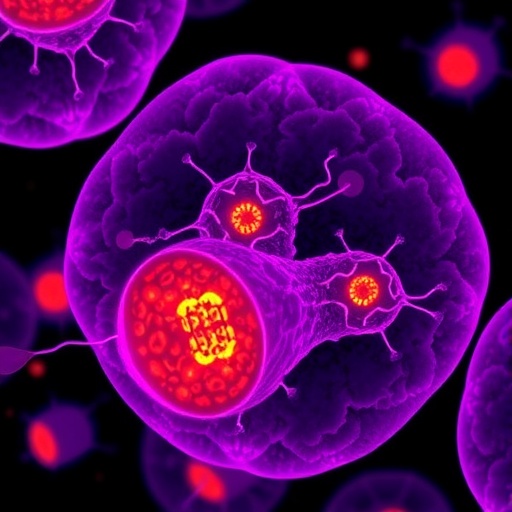In a groundbreaking advancement in cancer immunotherapy, researchers at the Massachusetts Institute of Technology have unveiled a novel strategy that effectively compels tumors to orchestrate their own eradication by activating a critical immune signaling pathway in neighboring immune cells. This innovative approach hinges on stimulating the cGAS-STING pathway within cancer cells, thereby triggering an immune cascade that culminates in the potent destruction of tumors. Importantly, the study demonstrates that when this method is combined with existing checkpoint blockade immunotherapies, the results in preclinical mouse models show significantly enhanced tumor control, underscoring its potential for transformative cancer treatment.
The cGAS-STING pathway functions as a sentinel system in cells, initiating immune responses upon detection of aberrant double-stranded DNA in the cytoplasm, a hallmark often associated with infections or cellular damage. Activation of this pathway prompts the production of type I interferons and other cytokines, crucial signaling molecules that mobilize immune cells to target abnormal cells, including cancerous ones. While scientists have long sought to exploit this pathway using synthetic STING agonists to stimulate antitumor immunity, clinical applications have been hampered by dose-limiting toxicities and insufficient efficacy.
To circumvent these challenges, the MIT research team, led by principal investigator Natalie Artzi and first author Alexander Cryer, devised an approach leveraging the tumor cells’ intrinsic biochemical machinery. By delivering messenger RNA (mRNA) encoding the enzyme cyclic GMP-AMP synthase (cGAS) directly into cancer cells, the process amplifies the intracellular synthesis of cGAMP—a natural activator of STING—thereby enhancing localized immune activation without the systemic side effects typical of conventional STING agonist administration. This intracellular biosynthesis ensures that cGAMP remains concentrated within the tumor microenvironment, facilitating effective immune engagement.
Cancer cells are unique in that their rapid and often error-prone division results in the accumulation of cytoplasmic double-stranded DNA fragments. This aberrant DNA normally serves as the substrate for cGAS to generate cGAMP. By increasing cGAS expression via mRNA delivery, the research team effectively boosted the production of cGAMP within the tumor, which is then secreted into the surrounding tumor milieu. This secreted cGAMP acts as a powerful paracrine signal that activates the STING pathway in adjacent immune cells, such as macrophages and dendritic cells, culminating in a robust antitumor immune response.
The team encapsulated the cGAS mRNA within lipid nanoparticles, a delivery vehicle that protects the mRNA until it reaches the tumor site and facilitates its uptake by cancer cells. In a murine model of melanoma, localized injection of these lipid-encapsulated mRNAs led to a significant slowing of tumor growth. Remarkably, when this treatment was administered in conjunction with checkpoint blockade inhibitors—drugs that release the brakes on T-cell activity—the therapeutic efficacy was markedly enhanced. In fact, the dual treatment eradicated tumors completely in approximately 30 percent of the mice, a feat not observed with either treatment alone.
Further analysis revealed that the mRNA-induced activation of the cGAS-STING pathway reignited the production of interferon and other immune modulators within the tumor microenvironment. This cytokine milieu catalyzed the recruitment and activation of diverse immune cell populations, including antigen-presenting cells that prime T cells for targeted attacks against cancer cells. The synergistic effect observed with checkpoint blockade therapy stems from this enhanced immune priming, which unleashes T cells’ cytotoxic potential more effectively.
One of the longstanding obstacles in harnessing STING activation for cancer therapy has been the systemic toxicity caused by delivering high quantities of synthetic STING agonists. These molecules, when administered in large doses, can provoke widespread inflammation and autoimmunity, limiting their clinical deployment. In contrast, the mRNA approach described here elicits localized, tumor-restricted cGAMP production, attenuating off-target effects while maximizing immunostimulatory activity precisely where it is needed. This targeted delivery strategy therefore holds promise for safer, more tolerable immunotherapies.
The advantage of stimulating tumors to manufacture their own immune activators also lies in the ability to amplify the pathway utilizing the cancer cells’ endogenous biochemical pumps and secretory machinery. This contrasts with exogenous administration of cGAMP, which faces rapid degradation and dispersal, diminishing its therapeutic window. By manipulating the tumor’s internal processes, the researchers have effectively “turned the tumor against itself,” enhancing immune cell recognition and attack.
Looking ahead, the MIT team aims to expand upon this promising strategy by refining the delivery system so it can be administered systemically rather than via direct tumor injections. A systemic administration mode would broaden applicability, especially for patients with inaccessible or metastatic tumors. Moreover, the researchers are exploring combining the mRNA therapy with DNA-damaging chemotherapies or radiotherapy, which could potentiate the therapeutic effect by increasing the availability of cytoplasmic double-stranded DNA substrates, thereby further stimulating cGAMP production.
This study represents a pivotal step forward in cancer immunotherapy development, exemplifying how leveraging fundamental cellular processes and innovative nucleic acid delivery vehicles can revolutionize treatments. By fine-tuning immune activation at the tumor site intrinsically and synergizing with existing immunotherapies, the approach may significantly enhance the efficacy of cancer treatments while minimizing systemic adverse effects, offering hope for more effective and safer cancer therapies in the near future.
As cancer treatment paradigms increasingly incorporate immunomodulation, strategies like this that harness endogenous mechanisms provide a blueprint for next-generation therapeutics. The possibility of reprogramming cancer cells to self-signal immune destruction marks an inspiring hallmark in the ongoing battle against cancer, illuminating pathways for scientific ingenuity to translate into clinical breakthroughs.
Subject of Research: Animals
Article Title: Restoration of cGAS in cancer cells promotes antitumor immunity via transfer of cancer cell–generated cGAMP
News Publication Date: 3-Nov-2025
Web References: http://dx.doi.org/10.1073/pnas.2409556122
Keywords: Cancer, Diseases and disorders, Health and medicine, Life sciences, Immunology, Immunotherapy
Tags: cancer immunotherapy advancementscGAS-STING pathway activationcheckpoint blockade immunotherapy combinationimmune cell mobilization against tumorsimmune responses and cytokinesimmune signaling in tumorsinnovative cancer treatment approachesMIT cancer researchpreclinical cancer modelssynthetic STING agonists challengestumor control enhancement techniquestumor eradication strategies





